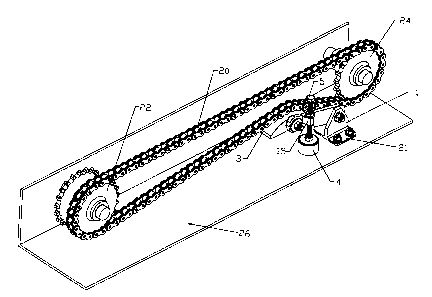Some of the information on this Web page has been provided by external sources. The Government of Canada is not responsible for the accuracy, reliability or currency of the information supplied by external sources. Users wishing to rely upon this information should consult directly with the source of the information. Content provided by external sources is not subject to official languages, privacy and accessibility requirements.
Any discrepancies in the text and image of the Claims and Abstract are due to differing posting times. Text of the Claims and Abstract are posted:
| (12) Patent: | (11) CA 2620980 |
|---|---|
| (54) English Title: | RUBBER BUSHING CHAIN TENSIONER |
| (54) French Title: | TENDEUR DE CHAINE A MANCHON EN CAOUTCHOUC |
| Status: | Expired and beyond the Period of Reversal |
| (51) International Patent Classification (IPC): |
|
|---|---|
| (72) Inventors : |
|
| (73) Owners : |
|
| (71) Applicants : |
|
| (74) Agent: | |
| (74) Associate agent: | |
| (45) Issued: | 2010-07-27 |
| (22) Filed Date: | 2008-01-04 |
| (41) Open to Public Inspection: | 2009-07-04 |
| Examination requested: | 2009-03-16 |
| Availability of licence: | N/A |
| Dedicated to the Public: | N/A |
| (25) Language of filing: | English |
| Patent Cooperation Treaty (PCT): | No |
|---|
| (30) Application Priority Data: | None |
|---|
This invention describes a compact, light weight, durable, quiet in operation, economical, chain tensioning device with means for controlling chain slack between two drive sprockets, found in all terrain vehicles or the like. The assembly comprises a chain tensioning device which is spaced between the two drive sprockets. The chain tensioning device is easy to assemble, install and adjust. The device exerts a modest pre- load tension pressure, requires infrequent adjustment and is suitable for reversed loads.
Tendeur de chaîne compact, léger, durable, silencieux et économique doté d'un moyen de contrôle du mou de la chaîne entre les deux roues d'entraînement des véhicules tout-terrain ou d'autres véhicules du genre. L'ensemble comprend un tendeur de chaîne placé entre les roues d'entraînement. Le tendeur de chaîne est facile à assembler, à installer et à régler. Le tendeur, qui exerce une modeste traction de précharge, ne nécessite pas de réglage fréquent et convient à la marche arrière.
Note: Claims are shown in the official language in which they were submitted.
Note: Descriptions are shown in the official language in which they were submitted.

2024-08-01:As part of the Next Generation Patents (NGP) transition, the Canadian Patents Database (CPD) now contains a more detailed Event History, which replicates the Event Log of our new back-office solution.
Please note that "Inactive:" events refers to events no longer in use in our new back-office solution.
For a clearer understanding of the status of the application/patent presented on this page, the site Disclaimer , as well as the definitions for Patent , Event History , Maintenance Fee and Payment History should be consulted.
| Description | Date |
|---|---|
| Time Limit for Reversal Expired | 2015-01-05 |
| Letter Sent | 2014-01-06 |
| Maintenance Request Received | 2012-11-14 |
| Inactive: Late MF processed | 2011-01-25 |
| Letter Sent | 2011-01-04 |
| Grant by Issuance | 2010-07-27 |
| Inactive: Cover page published | 2010-07-26 |
| Pre-grant | 2010-04-23 |
| Inactive: Final fee received | 2010-04-23 |
| Notice of Allowance is Issued | 2010-04-09 |
| Letter Sent | 2010-04-09 |
| Notice of Allowance is Issued | 2010-04-09 |
| Inactive: Approved for allowance (AFA) | 2010-04-07 |
| Amendment Received - Voluntary Amendment | 2010-03-15 |
| Inactive: S.30(2) Rules - Examiner requisition | 2009-12-11 |
| Application Published (Open to Public Inspection) | 2009-07-04 |
| Inactive: Cover page published | 2009-07-03 |
| Letter Sent | 2009-05-21 |
| Request for Examination Received | 2009-03-16 |
| Request for Examination Requirements Determined Compliant | 2009-03-16 |
| All Requirements for Examination Determined Compliant | 2009-03-16 |
| Amendment Received - Voluntary Amendment | 2009-03-16 |
| Inactive: IPC assigned | 2008-06-17 |
| Inactive: First IPC assigned | 2008-06-17 |
| Inactive: IPC assigned | 2008-06-17 |
| Amendment Received - Voluntary Amendment | 2008-05-28 |
| Application Received - Regular National | 2008-03-17 |
| Inactive: Filing certificate - No RFE (English) | 2008-03-17 |
| Small Entity Declaration Determined Compliant | 2008-01-04 |
There is no abandonment history.
The last payment was received on 2009-10-27
Note : If the full payment has not been received on or before the date indicated, a further fee may be required which may be one of the following
Patent fees are adjusted on the 1st of January every year. The amounts above are the current amounts if received by December 31 of the current year.
Please refer to the CIPO
Patent Fees
web page to see all current fee amounts.
| Fee Type | Anniversary Year | Due Date | Paid Date |
|---|---|---|---|
| Application fee - small | 2007-10-15 | ||
| Request for examination - small | 2009-03-16 | ||
| MF (application, 2nd anniv.) - small | 02 | 2010-01-04 | 2009-10-27 |
| Final fee - small | 2010-04-23 | ||
| MF (patent, 3rd anniv.) - small | 2011-01-04 | 2011-01-25 | |
| Reversal of deemed expiry | 2011-01-04 | 2011-01-25 | |
| MF (patent, 4th anniv.) - small | 2012-01-04 | 2011-12-30 | |
| MF (patent, 5th anniv.) - small | 2013-01-04 | 2012-11-14 |
Note: Records showing the ownership history in alphabetical order.
| Current Owners on Record |
|---|
| JOHN ROBERT NEARY |
| Past Owners on Record |
|---|
| None |